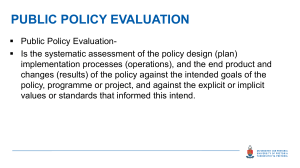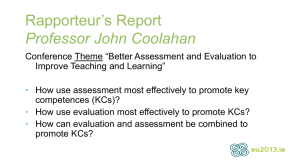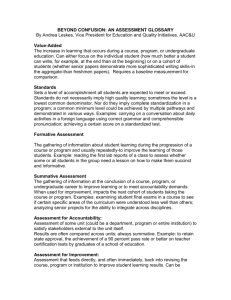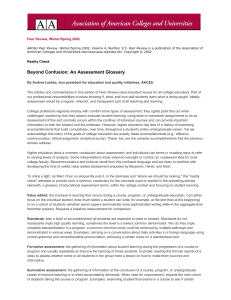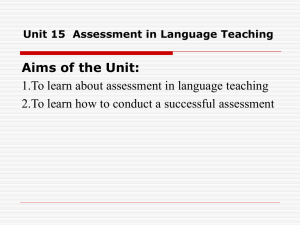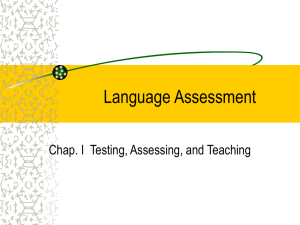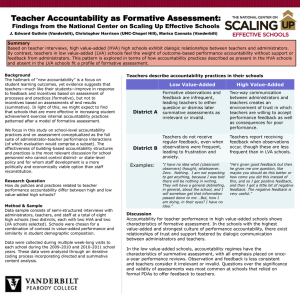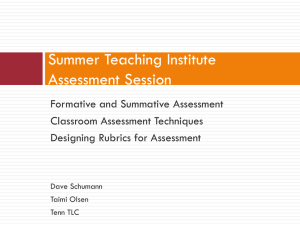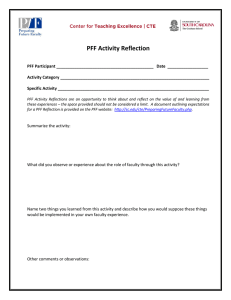Assessment 101 - University of Miami
advertisement
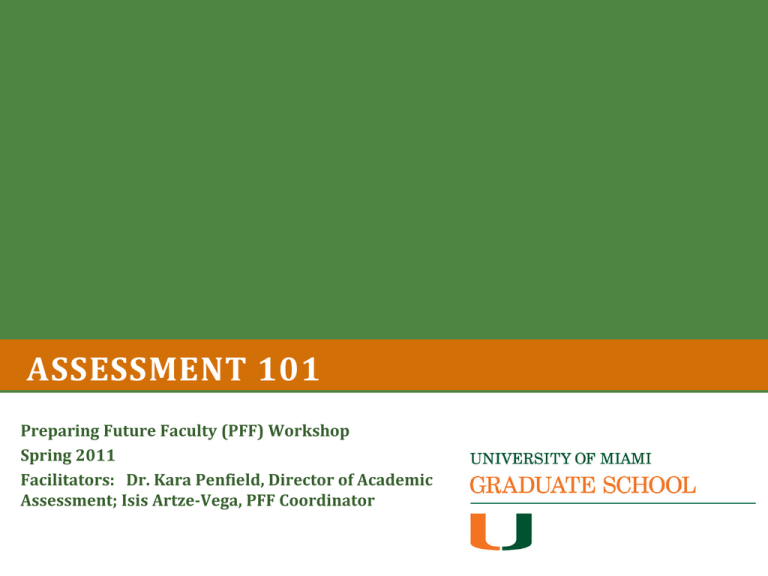
ASSESSMENT 101 Preparing Future Faculty (PFF) Workshop Spring 2011 Facilitators: Dr. Kara Penfield, Director of Academic Assessment; Isis Artze-Vega, PFF Coordinator Today’s workshop will… … describe the relevance of assessment to colleges and universities …provide an overview of assessment in education …familiarize you with various types of assessment …discuss the role of faculty in the assessment process …introduce techniques and assessment tools What is assessment? Generally speaking… “Assessment is the process by which information is obtained relative to some known objective or goal descriptions” (Kizlik, 2011). In education… “Assessment is the systematic collection, review, and use of information about educational programs undertaken for the purpose of improving learning and development” (Paloma & Banta, 1999). Relevance to Higher Education Today Increased demands for accountability in all levels of education. •In 2006, Secretary of Education Margaret Spellings proposed changes to the college accreditation process & recommended mandatory testing to measure college student learning. Why? •Soaring college costs, signs that college students aren’t learning key competencies & skills, and the lack of data to examine the outcomes of higher education •The govt. & general public are also interested in accountability and assessment because they are investing considerable funds and want to ensure their investment is worthwhile. Another key distinction… Classroom Assessment Program Assessment CLASSROOM ASSESSMENT Let’s talk a bit about your own experiences with classroom assessment. Two Main Types of Assessment FORMATIVE •Gathering info. about student learning with goal of improvement • Provides feedback •Ex: Non-graded quiz SUMMATIVE •Gathering info. at end of course or program to assign grades, meet accountability demands •Provides a final judgment •Often used to determine future action •Ex: Exam Examples of formative assessment oHomework exercises oDiscussion responses oJournal entries oPretests Formative assessment also includes CATs CATs are classroom assessment techniques •Main goals: Better understand how your students are learning & improve your teaching Examples: o Background knowledge probe o Minute paper o Muddiest point o One-sentence summary Angelo, T. A., & Cross, P. (1993). Classroom assessment techniques: A handbook for college teachers. San Francisco, CA: Jossey-Bass Classroom Assessment Cycle Phase I: Plan Focus on a goal, choose a technique Formulate appropriate response, try it out Teach the lesson, assess student learning, analyze the feedback Phase 3: Respond Phase 2: Implement Examples of summative assessment 4 Common formats: o Selected response items oMultiple choice, True/false, Matching, o Short answer o Fill in the blank, One or two sentence response o Extended written response (papers, essays, lab write-ups, portfolios) o Performance assessment PROGRAM ASSESSMENT Components of Program Assessment Mission Intended outcomes Assessment measures Results Interpretation Plan for improvement Common Intended Outcomes Oral and written communication Field-specific content knowledge Ability to think critically Common Measures Rubric Assessment Capstone Projects Conference Presentations Design Exhibits Clinical Rotations Student Perception Surveys Structured Group Interviews (Focus Groups) Different Levels Federal Govt. Regional Accreditors Institution Colleges/ schools Classroom Interplay b/w classroom & program assessment •The components of program assessment (slide 14) can be used in the classroom •Student products (essays, etc.) can be used in both… viewed through different lenses •Capstone projects & courses •General Education “Assessment is more than a response to demands for accountability, more than a means for curricular improvement. Effective assessment is best understood as a strategy for understanding, confirming, and improving student learning.” Higher Learning Commission

